Ralph Fiennes The White Crow
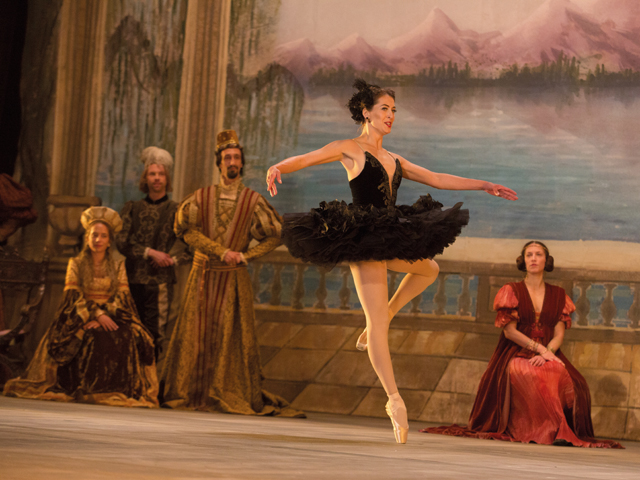
It is 1961
Cast: Ralph Fiennes, Louis Hofmann, Sergei Polunin, Adèle Exarchopoulos, Oleg Ivenko
Director: Ralph Fiennes
Genre: Biography, Drama
Running Time: 127 minutes
Synopsis: A young man of just 22, dressed in a black beret and a dark narrow suit, is on an aeroplane flying from St Petersburg to Paris. It is 1961 and Rudolf Nureyev, not yet the imperious figure of legend, is a member of the world-renowned Kirov Ballet Company, travelling for the first time outside the Soviet Union.
Parisian life delights Nureyev and the young dancer is eager to consume all the culture, art and music the dazzling city has to offer. But the KGB officers who watch his every move become increasingly suspicious of his behaviour and his friendship with the young Parisienne Clara Saint. When they finally confront Nureyev with a shocking demand, he is forced to make a heart-breaking decision, one that may change the course of his life forever and put his family and friends in terrible danger.
From Nureyev's poverty-stricken childhood in the Soviet city of Ufa, to his blossoming as a student dancer in Leningrad, to his arrival at the epicentre of western culture in Paris in the early 1960s and a nail-biting stand-off at the Le Bourget airport, "The White Crow" is the true story of an incredible journey by a unique artist who transformed the world of ballet forever.
The White Crow
Release Date: July 18th, 2019
About The Production
It was almost 20 years ago when actor-director Ralph Fiennes first read Julie Kavanagh's biography of the legendary Russian ballet dancer Rudolf Nureyev called 'Rudolf Nureyev: The Life'. Fiennes and Kavanagh were friendly and the writer knew the young actor was fascinated by Russian culture.
"Although I had no great interest in ballet and I didn't know much about Rudolf Nureyev, I was gripped by the story of his early life," Fiennes recalls. "His youth in Ufa in central Russia in the 1940s, his student years studying dance in Leningrad, now St Petersburg, and then culminating in his decision to defect to the West in 1961. That story got under my skin."
Although it was to be another 10 years before Fiennes would make his directorial debut with Coriolanus in 2011, he felt the story of Nureyev's early life to be very cinematic even then. "
The story sat with me as a great possibility for a film. I didn't really see myself directing it. It was just the idea," he explains. "It's so dramatic and is about so many things. It has an interior personal dynamic, the drive to realise himself and the ruthlessness that goes with it. It's also within the context of the ideological divide between east and west at the height of the Cold War."
Producer Gabrielle Tana similarly recognised the filmic potential of that particular part of Nureyev's story. Tana had produced both of Fiennes' actordirector projects, Coriolanus and The Invisible Woman and suggested a dramatic adaptation of Kavanagh's biography should be their next project together. Tana had a very personal attachment to the subject matter. She had been a ballet dancer as a child until she was 17 and had seen Rudolf Nureyev dance with Margot Fonteyn at the Royal Ballet as a young girl. The young Tana had even met Nureyev personally on a couple of occasions as Tana's mother had been friendly with a friend of Nureyev's.
"His life was so fascinating," Tana enthuses. "He was compelling as a person as well as such an exceptional artist. He put ballet on another level. He was a superstar."
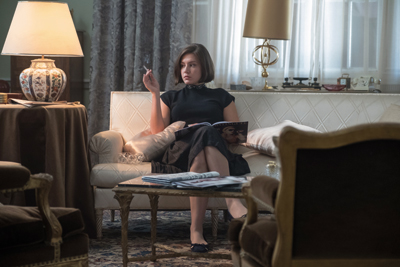 Fiennes and Tana were drawn to Nureyev as a performer who wanted to captivate. Before Nureyev, the audience's gaze was primarily drawn to the female ballerinas, with the male dancers effectively on stage as strong, handsome statues.
Fiennes and Tana were drawn to Nureyev as a performer who wanted to captivate. Before Nureyev, the audience's gaze was primarily drawn to the female ballerinas, with the male dancers effectively on stage as strong, handsome statues.
"He had a spirit in him, something that was stronger than him or anything else," Tana explains. "He was obsessed with dance, and obsessed with actually making his profile on the stage as significant as possible. He wanted to be as captivating as the ballerinas were and he reinvented male performance. It became much more dramatic. He wasn't just there to serve the ballerina. He was a dramatic player in her own right. Vaslav Nijinsky did it too, but with Nureyev it was very conscious. He wanted to make sure everybody was watching him."
Fiennes and Tana were not interested in making a biopic of Nureyev's life. "It was that character, that will of Nureyev's that made him realise who he was an artist that really grabbed me," says Fiennes.
"We wanted to make a film about somebody who was exceptional and who broke with convention," agrees Tana. "It wasn't conscious, it was something that was stronger than him. He wanted to be the best at what he was. He wasn't going to be held back or told what to do by anybody else."
Working On The Screenplay
Tana and Fiennes turned to renowned playwright and screenwriter David Hare to transform their idea into a reality. Fiennes knows Hare well as he has starred in several of Hare's great stage adaptations of Chekhov and Ibsen and on TV in Hare's political thriller Page 8.
"David Hare was our ideal writer," says Fiennes. "David writes what I call 'high- definition', provocative characters who have strong contrasting elements that are challenging for an audience. He writes those big spirits and he writes them brilliantly. Also David is known for writing things that have a strong political and social context. He has an instinctive understanding of the political climate in our story."
In fact, Hare reveals it was his love of French New Wave cinema of the 1960s, particularly the films of Louis Malle, which initially drew him to the project.
"The French New Wave is what my generation grew up on," Hare explains. "All those beautiful black and white movies of the 60s are what excited me and made we want to work in film. I read about Nureyev's time in Paris just before he defected. I wanted to write a movie that was just set in Paris in those months but Ralph was always adamant it would go back to Russia. That it would go back to both Nureyev's time in St Petersburg as a student of dance, but also to this incredibly deprived childhood that he had."
"I feel I have a good connection with David," Fiennes says of how he worked with Hare. "We batted many ideas back and forth, feeling the temperature and the tone and the shifts of what we wanted to do. It was very inspiring to sit with him and wrangle the challenges of structure and drama. We asked ourselves, 'What was the essential story we were trying to tell?' We were clear this was the story of young Rudolf's defection. I first thought it should be linear. What emerged in our discussion was the three time frame structure: Paris 1961, the Leningrad years from '55-'61, and the childhood years in the late '40s. These time frames interweave giving us a portrait of the evolution of this boy and leading us to a point at La Bourget in June '61. The timeframes come together at this point."
Writing a three-part structure appealed to Hare. "I've always thought three is a great number for a movie. When I did The Hours, which had a three -part structure, Guillermo Arriaga was writing Amoros Perros and we sent each other emails saying 'Isn't a three part structure just joy?'" he recalls, laughing. "Most films have twopart structures. They have an A -plot and a B -plot or they have a main plot and flashbacks to other events and that's boring because the audience knows. Once the audiences sense what the structure is, they're bored. The great thing with three is you never which one you're going to next. You never know which direction the film is going in and that keeps it fresh.
"The whole art of it, both in the writing and in the cutting room is to make it look inevitable, even though it is by no means inevitable, which way you're going to tell the story."
Like Tana, Hare had actually met Nureyev. But by then Nureyev was the most famous dancer in the world and "The White Crow" was not going to be about that Nureyev.
"The film is about the moments during which he becomes the most famous dancer in the world for two reasons. The first being his dancing and the second being that he was the first significant Soviet citizen to defect," says Hare.
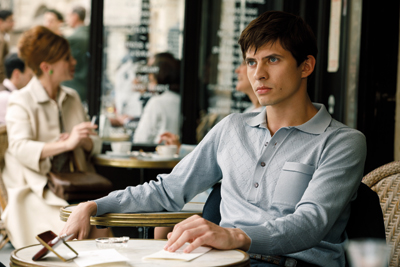 "The Nureyev I met was already regarded as a monster. Famously difficult, famously imperious. You certainly couldn't look at anybody else when you were in the room with him. I had to throw that memory away because that's not what he was when he came to Paris. He was always on an extraordinarily tough course because of the poverty of his background."
"The Nureyev I met was already regarded as a monster. Famously difficult, famously imperious. You certainly couldn't look at anybody else when you were in the room with him. I had to throw that memory away because that's not what he was when he came to Paris. He was always on an extraordinarily tough course because of the poverty of his background."
Hare underlines Nureyev was an autodidact who always considered himself running to catch up. "He felt not only was he working class, a peasant who knew nothing as he put it, but that he started dancing very late. I give him a line when he goes to the choreography school and says, 'I've got to do six years work in three' and as a result of that he had a voracious curiosity in art. He wasn't interested in just being what he would call a 'stupid dancer'. Traditionally and particularly in that period in the 1960s dancers were expected just to obey, not to think. They were expected to move their limbs in ways the chorographers told them to. Part of Nureyev's genius was he refused to accept that. He wanted the dancer to have a status and not just be a puppet. That's why he moved choreography on."
"He himself felt the male part in classical ballet was boring," Hare continues. "Traditionally, the man stood there and took up various, heroic poses while around him this beautiful little girl would dance and twinkle and star. It was a merging of sexuality and merging of gender that happened with Nureyev. He, at least to my eyes, is clearly a bisexual dancer. When you see film of him dancing, there is a bisexual element to it. But there's an employment of the feminine that is really creatively rich. It's not unmanly and it's not unheroic, but it is just much more expressive and much less wooden than traditional Soviet ballet."
Hare started by talking to the people who knew him best. "Clara Saint is still alive and managed his move to the West. She was my key witness to who he then was," Hare explains. "French dancer Pierre Lacotte, who was at La Bourget airport and who also helped him, was also extremely helpful. He could not have been more vivid in his descriptions of how Nureyev was then. Almost like a child, in some ways quite childish and in others devastatingly mature."
Hare's aim was to put Nureyev's defection into a context that underlines what an enormous gesture it was for Nureyev to make and the implications it had for the Cold War. His long-standing working relationship with Fiennes helped immensely.
"Ralph just understands my work incredibly well," Hare explains. "He can feel a scene. When he looks at a scene on the page, he knows exactly how he's going to do it and what he's going to do with it. As he's an actor he understands how the dialogue relates to what I think the action of the scene is. If I wrote a scene, he knows what the scene is. I never had to explain a scene to Ralph."
They were able to produce the screenplay they wanted to. ""Ralph and I worked alone," says Hare. "Nobody brought any pressure to bear or interfered with us. They let us write what we want.
Bringing Nureyev To Life
Authenticity is key to Fiennes' work as a director and he was keen to cast Russian dancers and actors and have them speak Russian to each other on screen.
"From the very beginning Ralph's stipulation was that the dialogue would be in Russian," David Hare explains.
"Ralph Fiennes is really the best loved Western actor in Russia. If you walk down a street in Moscow or St Petersburg with Ralph, it's like walking with a Bollywood star in Mumbai. They love him to bits. The reason the Russians love him is they know he's the only major actor in the world who's interested in Russia. He speaks Russian, he's really committed to Russian work and to being as authentic as possible in the film. To him, it seemed completely ridiculous to have a whole lot of English speaking actors and give them accents. For me it's completely wonderful as it means I get all these great Russian actors to speak my dialogue."
Finding his Nureyev was Fiennes' first big challenge.
"We employed two casting directors in Russia to do a big sweep which ended up with four or five candidates and I identified this young Ukrainian dancer, Oleg Ivenko, from the Tartar State Ballet company," Fiennes explains. "I felt he had a latent acting ability and he is a strong ballet dancer who has a physical proximity to Rudolf Nureyev."
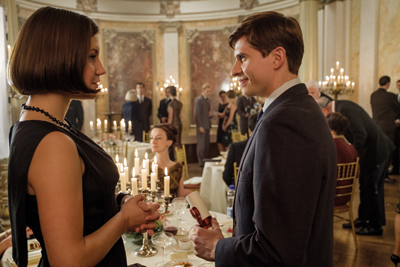 "When I did the screen tests I could see Oleg picked up immediately on direction," Fiennes continues. " If I demonstrated something, he got it very quickly. A couple of times I would say 'No, this is what I want' and I would demonstrate an attitude or a feeling and he very quickly got it. There was something about the way he sat in front of the camera, some 'X factor' that made me think 'That could be Rudi'."
"When I did the screen tests I could see Oleg picked up immediately on direction," Fiennes continues. " If I demonstrated something, he got it very quickly. A couple of times I would say 'No, this is what I want' and I would demonstrate an attitude or a feeling and he very quickly got it. There was something about the way he sat in front of the camera, some 'X factor' that made me think 'That could be Rudi'."
Fiennes, who been nominated for multiple awards for his acting work and won the BAFTA for best supporting actor for Schindler's List, then worked intensively with Ivenko to help him develop an understanding of screen acting. The young dancer had never acted.
"I pushed him to understand the best screen acting is rooted in being really present and in the moment," Fiennes explains. " You're reacting and listening, so the thing to get him to feel is 'don't show me you're angry or shy or irritated or whatever; just feel it, be it. Have it inside. If you really have it or are close to having it, it will reveal itself.
"It sounds quite simple, but it's hard to be really present and the beauty of his work is that he is very present. It's an uncluttered performance. He was very generous and allowed me to steer him a bit, but he has a real pure screen acting instinct. In the end I felt we were comfortable with each other quite quickly, there was a good working relationship."
Ivenko himself gives a dancer's insight into what made Nureyev special: "Rudolf had an incredible energy that he translated on to the stage," Ivenko explains. "He worked really hard at the top of his ability. He entered the stage and lived his life onstage. Quite often, dancers are like robots, they perform a combination of movements, but he came out and lived it. He gave his energy to the audience who could not help applauding him because the energy he emanated was just incredibly powerful. Everybody felt it, all his partners, the entire corps-de-ballet that danced next to him. They all sensed it was something extraordinary. He could do impossible things. It was mind-blowing. Even now, some young ballet dancers can't repeat what he could do.
"He was inspired by paintings, art, books and people who inspired him to act, to achieve. It was all connected in him. He listened to his inner voice and what was interesting to him personally. He followed this line and stuck to it. This is what is interesting about him."
Renowned Ukrainian dancer Sergei Polunin, who was a former principal at the Royal Ballet, stars in the film as Yuri Soloviev, Nureyev's roommate in Paris. Polunin was the subject of the documentary Dancer in 2017, also produced by Tana. Tana had got to know Polunin thanks to her research for "The White Crow". He has since gone on to appear in films including 20th Century Fox's Murder On The Orient Express. He describes the advice he tentatively offered to Ivenko, who he knows a little.
"It's a different level of energy," Polunin says of acting. "When you're dancing you completely lose yourself inside of it and it's a much bigger energy. When you do an acting scene it's very subtle and you have to be very controlled. Even a thought can affect what you see on the camera so you have to be very careful how you send that energy. In dance, you just lose yourself inside of it and you don't really remember much; you just go for it."
Fiennes cast the acclaimed Russian actor Chulpan Khamatova as Xenia Pushkin. Xenia is the wife of Alexander Pushkin (played by Fiennes himself) who is Nureyev's mentor and teacher at the Leningrad Choreography School. Khamatova was thrilled to be part of the production.
"For me, Nureyev is a very important person," says Khamatova. "Not only is he a great dancer, he changed his life and he was ready to do it and ready to turn his life 180 degrees. The time before Nureyev changed his life, for me, is the most important time in his whole life."
While researching the screenplay, Fiennes and Hare had seized on the significance of the years Nureyev had spent in Leningrad (now St Petersburg), as a student of the Vaganova ballet school, formerly the Leningrad Choreographic School, where fought to study under Pushkin, and also as a member of the city's sensational Kirov Ballet Company. Far from his own family in Ufa, central Russia, the Pushkins took Nureyev under their wing and into their home. When he was injured they helped him back to health. As former dancers, they wanted to help heal him. There was also a rumoured brief affair between Xenia and Nureyev.
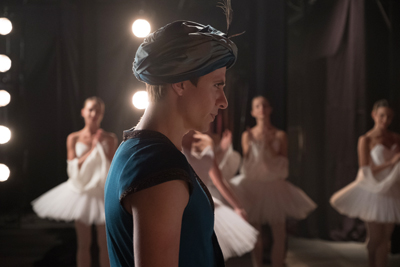 "The Pushkins were a very giving, generous and sympathetic couple who took great interest in wellbeing of the dance students," is Fiennes take on their relationship.
"The Pushkins were a very giving, generous and sympathetic couple who took great interest in wellbeing of the dance students," is Fiennes take on their relationship.
"Often they would invite students and give them tea or food in their oneroom apartment in the Vaganova school, this amazing classic building. From photographs you can see their apartment was full of elegant furniture and beautiful things."
"We're pretty sure, I can't prove it but nobody will disprove it, Nureyev had an affair with Pushkin's wife," says Hare. "'He was in the extraordinary situation in which the three of them were living together in a tiny apartment. The apartments in Leningrad at the time were absolutely minute even if you were as prestigious a figure as Pushkin."
"The White Crow' suggests one of the reasons Nureyev left was because the situation with the Pushkins had become oppressive as Nureyev realised he was homosexual.
"By that point he knew he was homosexual or predominantly homosexual as he did sleep with women His interests were homosexual," says Hare. "That is one of the powerful reasons why Nureyev thought of the West as freedom."
Perhaps most importantly, the Pushkins introduced Nureyev to the city's vibrant social and intellectual circles. Fiennes and Hare met with twins Leonid Romankov and Liuba Myasnikova (Romankova) who knew Nureyev from that time and recalled the many times the dancer had joined them and other students, in the Russian tradition of a Sunday meal full of laughter and drinking, where everyone exchanged ideas and dreams around the table. Indeed, the real twins feature in the scene, watching actors play their younger selves.
"They were extremely helpful as they had the clearest memories of Rudi in Leningrad in the 1950s which was part of his life," says Fiennes. "In "The White Crow', Rudi is embraced by Liuba and Leonid as this shy, interesting young boy who is curious. Rudi comes into this world that is new to him. These young people believed they were living in a world of change.
"The Soviet Union at that time looked like it would change and become a bit more liberal," Fiennes continues. "I talked to many people who lived through that time. Liuba for one said, 'At that time I didn't feel oppressed, I felt free in myself'. Her twin brother Leonid might say something different. In trying to understand this time, I came across contrasting views by some people for whom the system was clearly not great and others who accepted the system."
The filmmakers were very keen to avoid cliché in their portrayal of the Soviet Union in the late 1950s.
"I loathe this phrase 'the leap to freedom' which is used in relation to Nureyev and it's completely untrue," says Hare. "It forgets two things. First of all, it wasn't the bad times in Russia. On the contrary, things weren't as bad under Khrushchev as they were under Stalin. There was a tremendous feeling of optimism, that the only way things could now go was towards a loosening and more individual freedom."
Fiennes points to the nuanced character of Strizhevsky (Alexey Morozov), the KGB officer assigned to keep an eye on Nureyev in Paris. "Strizhevsky tries to control Rudi and doesn't want him to interact with Westerners. David and I felt strongly we wanted Strizhevsky to be intelligent and complex and we wanted his perspective to be understood. Through Alexey Morozov's brilliant performance, this believable and rounded person is brought to life."
Hare agrees: "I tried to show in the relationship between Nureyev and the KGB man that it was a relationship; they talked. The KGB man was around, everyone knew what he represented, but it was possible to have a personal relationship with him. He points out the great problem of all dictatorships; that he is going to be in worse trouble than Nureyev will be. He says to him, 'You think I bear down on you? I have someone bearing down on me' by which he means to say he's not the oppressor, he's trapped in the system- give him a break! Nureyev won't yield to that argument and in the scene before Nureyev makes his decision, the KGB man produces the strongest argument which did weight with Nureyev which is to say, 'If you defect to the West, it won't just be you who suffers, it will be your family. It will be your mother, it will be your sisters. They will suffer. Your family will be pariahs'. That was true and he did inflict terrible suffering on his family."
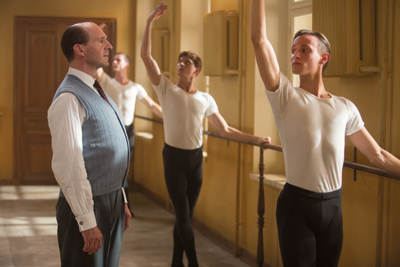 Fiennes himself plays Alexander Pushkin, Xenia's husband and Nureyev's inspirational teacher. "He was a revered ballet teacher in Leningrad," Fiennes says of Pushkin.
Fiennes himself plays Alexander Pushkin, Xenia's husband and Nureyev's inspirational teacher. "He was a revered ballet teacher in Leningrad," Fiennes says of Pushkin.
"He taught Nureyev and many other great ballet dancers. He taught using a seemingly very gentle, almost non-instructive technique where he allows the student to make the mistake and identify it and fix it. He speaks about the logic of the steps and the logic of the movement. I loved David Hare's portrayal of Pushkin." The off-screen relationship between Fiennes and Ivenko was therefore mirrored on-screen in the partnership between Nureyev and Pushkin. It is a symbiosis not lost on Tana, despite knowing the challenge it would present Fiennes to direct- for the third time– a film in which he also appears on the other side of the camera.
"I always felt Ralph should play the part and I thought there was something very beautiful in the notion of the director working with his star in that way, " says Tana. "I think that was meant to be. On the last two films that Ralph and I did together, he was both starring and directing in Coriolanus and The Invisible Woman and it pained me physically to have to watch him do what he was doing. I didn't want him to have to go through that pain again, but I did feel that this was something that was more contained, even though he was going to have to speak Russian. I felt that it would be beautiful if he did it, and it's very special."
When Nureyev arrives in Paris with the Kirov in 1961, he breaks down the barriers between the French and Soviet ballet companies to make two good friends in dancers Claire Motte (Calypso Valois) and Pierre Lacotte [Raphaël Personnaz). As the Pushkins did for him in Leningrad, they open the doors to French cultural and café life to Nureyev.
"When Pierre first saw Rudolf Nureyev dance he immediately understood he had something phenomenal in front of him," Lacotte suggests. "He realised he couldn't be that kind of dancer himself, but he was so generous and he wanted the best for Nureyev."
Calypso Valois says of Claire Motte: "They remained friends all his life. She had the best intentions towards him, and always very caring. They were equals, it wasn't because she just admired him; it was a mutual admiration. She was in her home country, and he was exiled so I think she was very caring and supportive."
Crucially, they introduced him to their friend Clara Saint, played by Adèle Exarchopoulos. Twenty-one year old Saint is a devoted ballet fan who has been recently bereaved. (Her boyfriend and his brother, the sons of novelist and then - French Culture Minister André Malraux, had been recently killed in a road accident.) Saint's reacts to seeing Nureyev dance, she loses herself in his performance, and the fog of her grief is temporarily lifted.
"She sees this boy dancing and for a few moments she forgets she's just lost the most important person in the world," Exarchopoulos explains. "They build this natural complicity together. She helps him in his curiosity of Paris. They get closer and closer. Of course, we all ask ourselves, what was the ambiguity in the relationship? But for me it's about friendship, real friendship."
Exarchopoulos has her own opinion of why many people, including Saint, put up with Nureyev's often boorish behaviour.
"I don't think you forgive him just because he has talent," she muses. "You forgive because you have to smell this boy to understand him. He will never let people and convention get to him. Freedom is more important to him than anything."
Exarchopoulos met the real Clara Saint during production. Unlike Motte, Saint had lost touch with Nureyev after his dramatic defection.
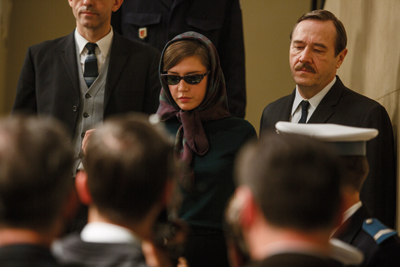 "It is always weird to meet someone and say, 'I'm telling your story' because it's a big responsibility," Exarchopoulos recalls of meeting Saint. "She told me about her memories, she showed me pictures, she told me about her childhood because what is the most interesting thing when you play a character is to know all the secrets that aren't in the script. What inspired me the most was her humility. She never tried to interject."
"It is always weird to meet someone and say, 'I'm telling your story' because it's a big responsibility," Exarchopoulos recalls of meeting Saint. "She told me about her memories, she showed me pictures, she told me about her childhood because what is the most interesting thing when you play a character is to know all the secrets that aren't in the script. What inspired me the most was her humility. She never tried to interject."
Fiennes was impressed by the naturalism Exarchopoulos brought to the role of Clara.
"Adèle has a strong quality of a deep interior life that makes me want to lean in," he explains. "I wanted an actress who had inner strength. Adèle's got an inner strength about her. She is quite different from the real Clara, but that difference is a good thing. Adèle has an amazing instinct for truth on screen. She'll never do anything that's phony or false."
Recreating The Three Eras Ralph Fiennes' quest for authenticity extended to the locations in which "The White Crow" was shot. "The story primarily takes place in two extraordinary cities, Leningrad (St Petersburg) and Paris. We really fought, Gaby really fought, for us to have the budget to shoot in these places," Fiennes explains. "Paris is expensive and Russia has its own demands in terms of practicality and permissions. But we all felt that we must shoot in these places. We needed that veracity."
The filmmakers had initially hoped to shoot all the Leningrad scenes in St Petersburg but the budget dictated only a week would be possible. Assisted by Natalia Smirnova's Russian production services company Globus Film (Fiennes had met then while filming Onegin in the country in 1998) the production captured St Petersburg's stunning exteriors in the late summer of 2017. They also filmed inside the Hermitage museum, the place in which Nureyev comes to absorb the city's treasures, including the Rembrandt Room. It was the first time the museum's authorities had allowed a film crew in since Alexander Sokurov's Russian Ark in 2002.
"It was because we were about an artist looking at art and that we weren't going in as tourists," Tana explains. "We were going in to pay homage to what a museum is all about. We had an amazing team there that helped get access and everything felt like it was actually not so difficult when we were there on the ground."
The production had a similar experience at the Louvre in Paris where it filmed the early morning scene in which Nureyev is captivated by Géricault's painting 'The Raft Of The Medusa', as part of six days in the French capital. It also captured the stained-glass interior of the Sainte-Chapelle, interiors and exteriors of the Paris Opera House, known as Palais Garnier, as well as the streets of the swinging city and the moonlit banks of the Seine.
"It's an aspect of Nureyev that moved me," Fiennes explains, as an artist himself. "I love going to art galleries when preparing a role, to have other things come in to your head that aren't specifically about learning your lines or in his case, practising your steps. You want to bring in thoughts and feelings form other sources. You want to expose yourself to other intuitions."
Production on "The White Crow" then moved to Serbia to recreate the remaining interiors on sound stages and quiet theatres. Fiennes and Tana had previously shot Coriolanus in Serbian and they had strong industry connections in the country.
"We shot a lot of the film in Serbia where we had fantastic government support, amazing crews and were particularly blessed by the production services company, Work in Progress," says Fiennes.
French production designer Anne Seibel recreated interiors including the Vaganova school in Leningrad, the Mariinsky Theatre in the city where the Kirov performed and Paris-Le Bourget airport on Serbian sound stages. She singles out the airport set as her favourite.
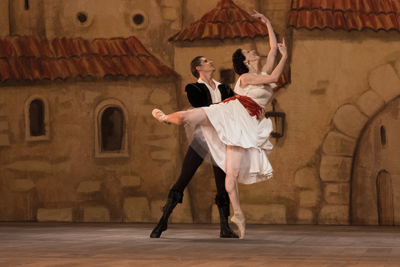 "I used Ralph's storyboard of those scenes to make the set useable for Ralph to do his scenes," she explains. "For example the stairs are not in the place they should be but to make it easier for the action I changed the position of them."
"I used Ralph's storyboard of those scenes to make the set useable for Ralph to do his scenes," she explains. "For example the stairs are not in the place they should be but to make it easier for the action I changed the position of them."
Seibel appreciated the precise nature of her director. "He knows what he wants," she says of Fiennes. "He's an artist and I could feel that he really loved this film and I felt from the beginning that he wanted to create something beautiful. For me it was like creating a piece of art."
Seibel worked closely with French costume designer Madeline Fontaine, who has previously worked on period pieces such as Pablo Larrain's Jackie.
"The first thing you do when you start on a project like this one with a lot of extras is to go around to fashion houses and search for what you can find," Fontaine explains. "Sometimes in these places you find some special pieces which could be used for some actors and then you can start to find your way to the characters, to the colours and to the specificity of the characters."
Make up and hair designer Lizzi Lawson Zeiss was part of their close-knit team. Like Seibel and Fontaine, she benefitted from the extensive research Fiennes had undertaken.
"What I love about him is his attention to detail is consummate," she says. "You never relax because if you miss something or if something changes he notices it instantly. His work ethic is extraordinary.
"What we did with our Russian cast was to keep them with a very 1950s look," Lawson Zeiss reveals. "Then with our Parisian cast, we've made them true 1960s, so each part tells a completely different story.
"With Rudi, if you look at all the photographs of him his hair was constantly changing, evolving, getting haircuts. He went backwards and forwards. We decided he would have one haircut that would always be one length, but within that we would dress it in different ways. When we see him in 1955 we try to make him look a bit more boy-ish, bring it all forward. Then as he starts to get into the story more, we change it. We had to decide on one haircut that would take us through to 1961 and then find things to do within that to suggest change or moments.
"What was interesting was when he got adopted by the Pushkins, there's definitely a change in him," Lawson Zeiss muses. "They took him in, they housed him, and they fed him and treated him like a son. Xenia was buying clothes for him and feeding him properly, and obviously you start to see some changes in him. He becomes a little bit smarter, a little bit more put together."
Lawson Zeiss opted to tone down Ivenko's stage make up. "Nureyev's makeup was always quite strong and very, very theatrical and when we tried to do this it just looked like it was way too much, so we've just refined it a little bit," she explains. "It's still very theatrical and has an essence of Rudi's make-up but it's not quite as brutal."
Music also played a vital part in signalling the different eras to the audience. "For the early era of the Soviet Union I wanted to do something that was very classical Russian so I drew from my own Russian heritage," says music composer Ilan Eshkeri. "I also drew from my knowledge of Tchaikovsky in particular, because we know Nureyev loved his work as do I."
Eshkeri wrote all the incidental music for "The White Crow" including a piece of violin music that was used throughout the Soviet scenes which was performed by world-renowned violinist Lisa Batiashvili.
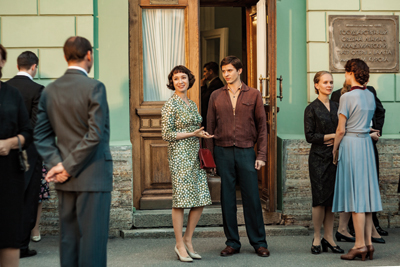 "For Paris, I wanted to do something that was startlingly different, but using the same players and the same instruments, a solo violin for Nureyev and also a full symphony orchestra," he explains. "I thought, 'We're in Paris, we're in the 60s, and this is a melting pot of artistic ideas, talent, philosophy and all these things are going on'. It's exciting and needs to be the cutting edge."
"For Paris, I wanted to do something that was startlingly different, but using the same players and the same instruments, a solo violin for Nureyev and also a full symphony orchestra," he explains. "I thought, 'We're in Paris, we're in the 60s, and this is a melting pot of artistic ideas, talent, philosophy and all these things are going on'. It's exciting and needs to be the cutting edge."
Eshkeri decided to compose a modern (for the time) minimalist style of classical music that was harmonically a world apart from the more traditional, classical, romantic style. "When they arrive in Paris you get this piece of music and it just is bright and bold and contemporary," Eshkeri says. "For me that is Nureyev. He's slapped in the face with this whole other world."
When it came to the Leningrad scenes of the 1950s, it was decided not to use any music at all. "Sometimes when you're writing music for a movie that's a really important part of the job," Eshkeri explains. "Working out when not to have music is as much my job as working out where there needs to be music. Sometimes deciding to not have music is more difficult."
Fiennes, who worked with Eshkeri on both Coriolanus and The Invisible Woman, says he is wary of too much music. "I don't like films where music is poured all over the film to somehow boost emotion and drama. I feel uncomfortable if I feel that I'm being manoeuvred by the music in the film, but I recognise there's a place for music," he says. "Rudolf loved music.
He taught himself to read music and play the piano, so it seemed to me that we shouldn't be shy of it."
We first hear the theme Eshkeri wrote for Nureyev when he is standing in the Louvre looking the' Raft of the Medusa'. "We see this boy soaking in this painting," says Fiennes. "The music runs alongside it and inside it." As is usual for him when working with Fiennes, Eshkeri joined the production much earlier than a composer usually would on any other project. "One of the reasons I love to work with Ralph is we start really early in the process," he explains. "I felt immediately there was a very emotionally complicated story to tell. Complex emotion is something music can express. Emotions that are conflicting or things that words cannot describe and in fact I often think, isn't that the point? When you're looking at a film and the performances and script are strong and it's filmed beautifully, what is the music trying to do? It's trying to give you that something extra where words and dialogue can't go. There was a great opportunity to do that in this film.
"When Ralph and I would meet and talk before I'd written anything or as I was writing, we would always speak about feelings and emotions at great length, especially about what we believed Nureyev was going through at this moment in time, what this very complicated, fascinating, conflicted and artistic character was going through. Just so he could dance."
Working With Ralph Fiennes
Doing double duty as actor and director meant Fiennes relied heavily on his firstclass technical collaborators including cinematographer Mike Eley, ballet and choreography consultant Johan Kobborg and script supervisor Susanna Lenton.
"I realised early on he was composing incredible shots and we were in sync with each other," Fiennes says of Eley. "I would have an idea of what the scene was, where possible angles might be, so we did a lot of advanced prepping and location work and when we came to shoot, a lot of the work was done. We looked at plans and talked about blocking scenes in advance so that on the day for the most part I just knew Mike was doing it and it was looking great. Part of me was able to not worry. I quickly realised I was blessed with this extraordinary cinematographer who was following through on everything we had discussed. He was very open to any suggestions and was also bringing his own poetry and vision. It was one of the great creative relationships I've had."
When it came to recreating the ballet scenes, Fiennes drew on some high level support. "I was out of my comfort zone shooting ballet," Fiennes admits. "I've not grown up with ballet so I had to immerse myself as much as I could. It was certainly a challenge."
"I met Carlos Acosta briefly to see him dance," he recalls. "He said to me 'Oh you're doing a film about Rudi? Well, remember that while we jump for a living we can't jump continually'. I realised you had to be very aware of a dancer's stamina. Unlike an actor you can't do 40 takes, not that I do 40 takes - I can do seven to 10 takes with an actor and that's okay, but you can't easily do the same with a dancer." The leading Danish ballet dancer and choreographer Johan Kobborg joined the project to work with Fiennes on the ballet scenes. They included some historically correct excerpts danced by Ivenko.
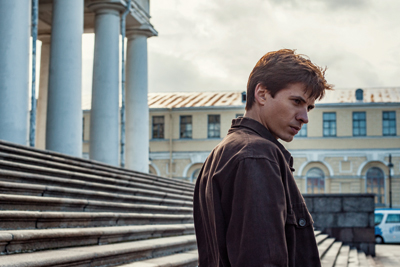 "Choreographing and dancing for film are very different processes," Kobborg points out. "You are trying to convey that same live energy, but you have to keep that fire going for let's say 10 to 12 hours a day, just for filming a few minutes of dance. By using different angles of placing the camera you can tell a story. You can tell the same story in so many, and it gives a lot of room for interpretation. It also has to work for both the connoisseur and the person who sees ballet for the first time. Finding that balance was interesting."
"Choreographing and dancing for film are very different processes," Kobborg points out. "You are trying to convey that same live energy, but you have to keep that fire going for let's say 10 to 12 hours a day, just for filming a few minutes of dance. By using different angles of placing the camera you can tell a story. You can tell the same story in so many, and it gives a lot of room for interpretation. It also has to work for both the connoisseur and the person who sees ballet for the first time. Finding that balance was interesting."
Fiennes has worked with script supervisor Susanna Lenton on his previous two films as director. "When I'm in a pressurised situation, we'll make eye contact and she'll help me with the performance. She has a brilliant instinct for film acting and we developed our own shorthand."
"With the right people around you it is manageable, without that it wouldn't be," he admits. "Also we had a fantastic cast of actors who were very accommodating and that's what you hope. It's very odd for a cast for the director to be directing one moment and then acting the next. You're grateful for their patience and tolerance. Generally, there's a spirit of support. There's a collective spirit of wanting it all to work out for the best and I felt that support from everyone."
"He surrounds himself with people who love him and he needs that because otherwise the task before him would be absolutely impossible," David Hare points out. "Unless the atmosphere were totally supportive, I don't think it would be possible for him to do what he does."
Fiennes' cast are effusive in their praise of their director.
"Ralph Fiennes is so precise in his directions and so in love with the characters and his work. We could do 20 or 30 or 40 takes of the same sequence and every time he will ask you something different, something precise, but it doesn't mean what you have done is not good. He just wants to explore," says Raphaël Personnaz (Pierre Lacotte).
"I felt completely supported. I had the feeling that I was in his hands and because he is an actor, a great actor, he can help with the small details," contributes Chulpan Khamatova (Xenia Pushkin).
Calypso Valois (Claire Motte) points out the unique advantage of working with a director who is also an actor too. "Ralph has so much empathy for us. He is always positive and underlining what's positive. Of course, when he wants something he will let us know. He will say, 'this is really good but we need to add this or that' and he is very soft, not pushing us, he is very caring with his actors," she says.
It's a quality Adèle Exarchopoulos also noticed in Fiennes. "He's really subtle and precise. When he comes to see you, you can see in his head that there's all the scene, all the emotion, all the details. It's fascinating to see how involved he is. He's really helpful and he's ready to listen."
She laughs as she remembers her initial reaction when she was first asked to read with Fiennes for the part.
"To be honest I was like, 'I'm going to read with Voldemort!'"
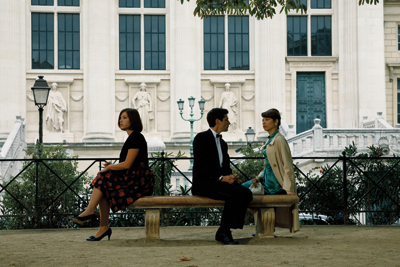 Remembering Rudolf Nureyev
Remembering Rudolf Nureyev
Rudolf Nureyev was one of the greatest ballet dancers of the 20th Century and a key figure in the cultural battles of the Cold War. But when he was researching the project, director Ralph Fiennes realised many younger people had never heard of Nureyev. It put an interesting spin on how he portrayed the period of his life covered by "The White Crow".
"It is a portrait of the artist as a young man with all his jagged edges and his loneliness and his imagination and his mischief," smiles Fiennes. "There's an unpleasantness and a ruthlessness to him, but it's youth looking to realise itself. And I find that very moving."
It's meant for people who don't know," says David Hare of "The White Crow". "The events took place a very long time ago and people don't know the story of Nureyev. I wanted to tell that story and spread some respect for the incredible dedication you need to be brilliant in an art form and how hard you have to work to be that good. It's very rare to see that represented on film and I love the way Ralph has done that."
Of Nureyev's behaviour during the time depicted in the film, Hare says it would not be countenanced now. "He would be sent on an anger management course!" he laughs. "In Nureyev's defence, everyone will say the ruthlessness was as much with himself as it was with other people. I didn't want to pull back on the selfishness. Unless you represent the selfishness you're not really telling the story of Nureyev. He isn't yet calcified. He isn't somebody who is expected to behave badly so that means when he behaves badly, his bad behaviour really upsets people in a profound way."
Finally, Fiennes does not believe Nureyev had any intention of defecting from the Soviet Union to the West.
The White Crow
Release Date: July 18th, 2019
MORE



